Berry bushes are often affected by many pests and diseases. Among them are powdery mildew, and mites, and aphids. In the fight against these pests, gardeners use a wide variety of pesticides. However, there is one catch here - the treatment of shrubs with the help of chemical solutions and mixtures can adversely affect the crop (berries watered with pesticides cannot be eaten). Many of us have heard of a simple pest control technique: boiling bushes. When is the best time to water bushes with boiling water? Why is this being done? Can other berry bushes be watered? Let's try to figure it out!
Why treat shrubs with boiling water
Watering shrubs with boiling water is effective in combating the bud mite, which is the main distributor of terry. It settles in the buds of the plant in early autumn and takes refuge in them throughout the winter. As soon as the kidneys begin to wake up, ticks begin their activity. Females lay eggs, and after two weeks, disfigured leaves appear in place of the kidneys, similar to miniature bitten heads of cabbage. After another three weeks, the shrubs take on a miserable appearance: there is almost no greenery, the remaining leaves are faded and underdeveloped, new shoots do not develop. With the beginning of autumn, the mites again move into the kidneys, and everything repeats. Watering the branches of shrubs with boiling water allows you to destroy the tick individuals, thereby interrupting the process of its reproduction.
When shrubs are treated with boiling water
Shoots of berry bushes become a refuge for pests in the winter. The larvae and fungal spores hibernate. A simple remedy - boiling water, will help in the fight against adversity. Processing should be carried out either in late autumn or at the end of February, before the start of sap flow and bud break. Water + 80 ... 90 ° C is poured into the watering can.

What shrubs are treated with boiling water
First of all, determine the objects to be treated with boiling water. Include all plants that suffered last year from powdery mildew, various spots and pests such as aphids, mites, etc. Map out a route for how you will move from bush to bush. You can’t run around with boiling water around the site, look for something else to process. It will be necessary to act quickly, clearly, decisively. Boiling water is poured over mainly blackcurrant and gooseberry bushes.

The technology of processing shrubs with boiling water
In order for the method of applying heat treatment to be as successful as possible, you need to know not only when to carry out work, but also how to do it:
- Pour boiling water into a suitable container or bucket and, without hesitation, we go to the garden where we grow berry bushes. By the time you reach the bushes, the water temperature will drop to about +80 °C, and upon contact with the branches, the water will lose about 10 °C more and will be in the range of +60–65 °C. That is why take a thermometer with you to control the temperature of the liquid - if the temperature drops too low, then the effect of watering will be zero (using too hot water can harm the plants themselves).
- Additionally, to enhance the effect of the solution, add salt or a little potassium permanganate to the water.
- Scald the branches evenly, trying not to miss any of them, so as not to leave the pests a single chance. The soil around each bush should also be treated with boiling water. But pouring hot liquid directly on the roots of plants should not be. To protect the root system, use iron sheets.
- Hold the watering can at a distance of about 10 cm from the branches. Water each shoot for no more than 5 seconds. One bush requires about 5-6 liters of water.
With shrubs, some gardeners act even tougher - pour them over hot water. Usually this treatment is carried out from a watering can, making sure that there is at least 1 m from the watering can to the bushes - boiling water, flying this distance, cools down and will not harm the kidneys. More often, the treatment of plants with boiling water is transferred to the spring, since such treatment stimulates the kidneys to awaken, which brings more benefits in the spring.

Watering bushes with boiling water from a bud mite
The procedure for watering with boiling water is shown mainly in case of damage, or for the prevention of damage to shrubs by a kidney mite. This is the most dangerous pest for culture and it is very difficult to deal with it. Some gardeners, considering him completely invincible, do not take any measures to exterminate him. The size of this pest is 0.2 mm in length. It belongs to the class of arachnids. These pests appear simultaneously with the first leaves, and are the main distributors of terry - a dangerous viral disease that significantly reduces the yield of the bush. A sign of the presence of these pests on the plant are swollen buds. With their awakening, ticks begin their vigorous activity. Indeed, from early autumn, throughout the winter, the buds of shrubs were their refuge.
The end of winter and very early spring, this is the time when you need to start showing some activity in your area. There will be enough work at this time for both gardeners (the trouble with seedlings alone is worth it!), And gardeners.
There are certain procedures in the garden that need to be carried out at this particular time, when most of the "inhabitants" of your garden are just about to wake up after winter. While they are not yet fully awake, you can carry out some procedures practically under a kind of "anesthesia".
Today we will talk about one such procedure, namely, about watering currants with boiling water. It seems that boiling water is dangerous for living organisms, but for some plants it is very useful if you do everything right.
Pour currants with boiling water. Why do it?
Why do such a procedure at all?? This simple action will help her get rid of many garden pests. The effectiveness of such irrigation in this respect is very high. So you can easily raise the overall immunity of currants.
In addition, boiling water will warm the soil to a certain extent, and its effect can serve as a prophylaxis against a large number of very dangerous diseases. If you add salt to the treatment solution, or replace it with blue vitriol, or potassium permanganate, then the results from watering with boiling water will be even better.
With the help of boiling water, you can significantly improve the overall sanitary situation in your garden. This technique will also help increase productivity. The hot water that you pour on the currant will increase its survival rate, it will be able to resist other negative factors well.
When to water?
The answer here is simple - such watering is carried out in very early spring, that is, at a time when the snow is still lying, and always before the buds appear on the bushes. Such watering should not be carried out spontaneously, but always competently and thoughtfully. Here you need to prepare everything.
First of all, identify currant bushes that have suffered from various insects (for example, , or ) and diseases (often ).
Think about the order of the processing itself.
You must have the tool completely ready. This is a watering can (the presence of a strainer on it is mandatory), or a bucket and a metal scoop. You will also need a thermometer, and of course, boiling water itself.
How to water?
The technology of such irrigation is also an important thing, of course. Boiling water should be poured into a container suitable for it, and immediately go to the currant bushes. During this short time, the water will cool down a little, somewhere up to 80 degrees.
When the water comes into contact directly with the branches of the currant, or with the soil, then its temperature will drop even more, already up to 60 degrees. You still need to have a thermometer with you so that you can control the temperature of the liquid during irrigation.
If the water is very cold, then such watering will not give a good effect, and too hot water can scald the currants and burn them.
Boiling water must be poured over the branches evenly. You should not miss a single branch, so that the pests have no chance to escape. Be sure to shed the earth around the bush too.
But, boiling water should not get on the roots. To completely eliminate this, you can protect the roots, for example, with metal sheets, or other material that will prevent boiling water from getting on them.
The watering can should not be brought close to the branches. Maintain a distance of about 10 cm from them. It is dangerous to bring the watering can closer. One area needs to be poured with boiling water in 5 seconds.
Boiling water with which we pour, helps to destroy many pests that were able to successfully winter. You will do this without chemistry, and besides this, such a procedure can significantly increase the yield of treated currant bushes.
The procedure for such watering is quite simple and rather transient. And how to do it, you will be shown in this video. We look.
D. Bogatyrev
P.S. Was the article useful, interesting to you?
Most gardeners cannot imagine their plot without currant bushes. And not only because of the amazing sweet and sour berries, but also because of the leaves, thanks to which you can make a healing tea. In summer, you can use fresh leaves for this, and dried in winter.
Therefore, you simply must plant at least a few currant bushes in your country house.
But, unfortunately, it happens that the bushes wither, stop bearing fruit, shed their leaves and dry up. This happens when plants are damaged by pests or diseases.
One of the methods aimed at maintaining the health of currant bushes is the treatment of currants with boiling water in the spring. It sounds crazy - but the effectiveness of such watering has been tested by many gardeners.
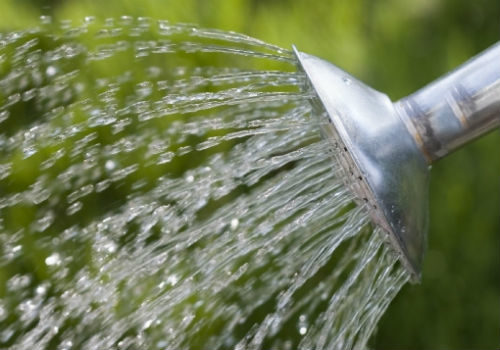
Watering from a kidney mite
The procedure for watering with boiling water is shown mainly in case of damage, or for the prevention of damage to currant bushes by a kidney mite.
This is the most dangerous pest for culture and it is very difficult to deal with it. Some gardeners, considering him completely invincible, do not take any measures to exterminate him.
The size of this pest is 0.2 mm in length. It belongs to the class of arachnids. These pests appear simultaneously with the first leaves, and are the main distributors of terry - a dangerous viral disease that significantly reduces the yield of the bush.
A sign of the presence of these pests on the plant are swollen buds. With their awakening, ticks begin their vigorous activity. Indeed, from early autumn, throughout the winter, currant buds were their refuge.
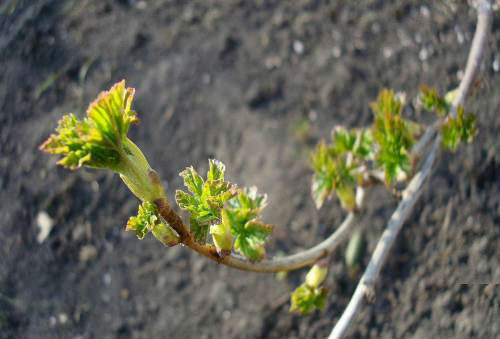
In the spring, female currant mites lay their eggs, and after half a month, in the place where there were swollen buds, deformed, disfigured, poorly developed leaves already appear.
In summer, such currant bushes have a painful appearance, lag behind in growth and development. Their leaves are practically absent, and the single ones that have been preserved have a miserable appearance.
In autumn, currant mites again settle in whole, intact buds, which since autumn begin to swell, round, and the whole process is repeated again.
This type of tick is very sensitive to high temperatures, therefore, watering the currant bushes with boiling water is able to stop and destroy it.
When should currants be treated with boiling water, the timing
The procedure should be carried out when there is confidence that boiling water will certainly fall on pests.
Carrying out this procedure in the autumn will not bring results, since ticks hide in tightly closed kidneys.
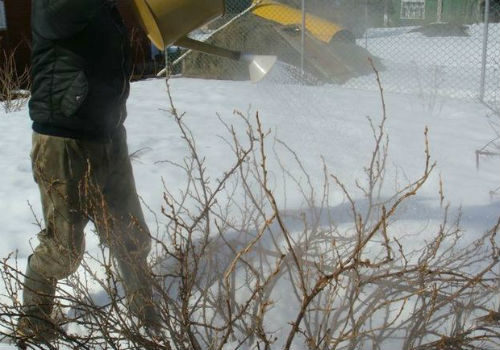
But in the spring, when the tick moves to new habitats - young shoots and intact buds, the pest is most vulnerable.
This happens during the swelling of the buds or the extension of the bud, but always before the start of flowering.
When the buds bloom, it is no longer possible to process them, because boiling water can damage them.
Spring watering is carried out at a time when there is snow, but the first thawed patches are already appearing - approximately in early or mid-April. When choosing a watering period, it is imperative to take into account both weather conditions and the state of the plant itself - its buds.
In autumn, you can also carry out a similar treatment, but it will already be aimed at combating other pests and diseases - aphids and powdery mildew.
Autumn watering with boiling water is carried out approximately in October, even before negative temperatures are established.
How to carry out the procedure correctly
Before you treat the currants with boiling water, you should outline the course of work - determine the bushes that should be watered, remove dead, old shoots, and tie the rest for ease of watering.
Buds that are too swollen - clearly damaged by a tick, preferably immediately, before watering, remove manually and burn. Protect the root system by placing boards under the bushes, or any other improvised covering material.
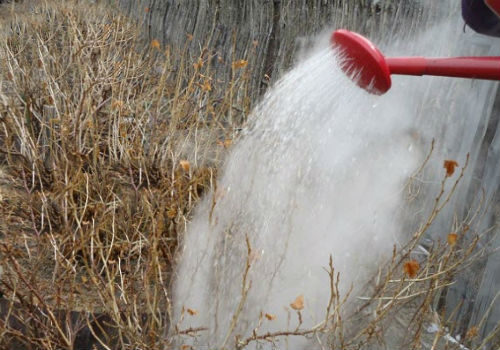
Prepare a metal watering can, as plastic can be deformed from boiling water.
The watering can must be equipped with a shower head for uniform watering. If the currant bushes are high, then you immediately need to take care of what you have to stand on during the processing. In advance, you need to prepare a stepladder, bench or chair. Some gardeners, to increase the efficiency of processing, add salt to the water, and preparations such as copper sulfate or manganese.
During the transfusion of water and overcoming the distance to the currant bushes, the temperature will drop slightly. But you need to take into account that it should not be lower than 70 ˚С, so it is better to have a thermometer on hand, since watering with chilled water will not have the desired effect.
Boiling water treatment of one area should not exceed five seconds.
The consumption of boiling water is 10 liters per two or three currant bushes, depending on their age. For old, overgrown bushes, this volume is enough for only two bushes, and if the bushes are young, not overgrown, then for three.
When watering, you should try to ensure that the plants spill evenly, all shoots of the bush and buds must be processed. Otherwise, the remaining pests will multiply again and have a detrimental effect on plants.
Thus, watering currants with boiling water in spring is an effective procedure aimed at combating diseases and pests, as well as obtaining a rich and high-quality harvest of berries.
Currant grows on almost every garden or suburban area. The taste of this berry is familiar to most of us since childhood. But to get good harvest and delicious fruits, you need to constantly care for the plants. The reason for crop failure can be violations of agricultural technology, but most often pests cause the greatest harm. Many of them easily endure the winter, and in the spring they begin to destroy currants.
You can learn how to protect raspberry bushes from diseases and pests.
Watering currants with boiling water: why and when is it better to do it?
Berry bushes are a good refuge for pest larvae, fungal spores. Therefore, currants constantly need to be processed from a wide variety of pests and diseases. There are several dozen of them in total.
Early spring currant processing includes two main stages. First of all, it is necessary to burn plant debris, and then dig up the soil around the bushes and in the aisles. This gives a good result.
But larvae and spores are also found on the bushes themselves. There are several ways to get rid of them. For example, treat currants with boiling water before buds bloom on it. This is a well-known and effective method of pest control, which is used in late February - early March. A similar procedure is also useful in that it increases the immunity of currants. IN middle lane It is better for Russia to pour boiling water over currants in early March. The snow had already melted at that time, and the buds on the bushes had not yet blossomed. If leaves have already appeared, then it is impossible to pour boiling water over the bushes so as not to burn them. It is necessary to ensure that the boiled water has cooled to 80-90 degrees.
The greatest harm to the currant is caused by a tick that wakes up in the spring, after hibernation. The infection can be transferred from soil to bush or from bush to bush by the wind, birds, and people themselves can become carriers of larvae and spores in the garden. Female ticks start laying eggs after the buds begin to bloom. And after about two weeks, already disfigured leaves appear in their place. By watering currant branches with hot water, you harass the tick and thus interrupt its reproduction.
If the plant is not treated on time, then in the fall, harmful creatures again take root inside the kidneys in order to survive the winter. As a result, swollen formations appear on currant bushes, which are easily visible on black currants, but are completely invisible on red ones. During this period, it is useless to use boiling water to treat currant bushes, since the protective shell of the kidneys in which the ticks hid is strong. It will withstand such treatment, and the pests will remain intact.
When the buds begin to swell, you need to carefully and carefully inspect all the bushes. There are thousands of mites in an overly enlarged kidney, which can only be seen with a strong magnifying glass. The eggs laid by the females hatch into larvae. The process is repeated, and the kidneys affected by them dry up. Deformed buds should be plucked out, and if there are several such swollen buds on one branch, then it is better to cut it off. Then all this must be burned.
Among other things, the tick that settled on the currant is the cause of terry. This is a dangerous viral disease of the berry that affects the entire bush. Currant flowers are interpetalous, and when infected with a virus, they become separate-petaled, seemingly terry. The flowers stretch out, acquire a lilac hue, and no longer form ovaries. As a result, the bush ceases to bear fruit.
With the disposal of the tick, when treated with boiling water, powdery mildew fungi are also destroyed. This is the causative agent of another disease - powdery mildew of plants. The disease leads to the fact that the growth of the plant stops, and it dies.
Some gardeners and gardeners do boiling water treatment at the end of October, but this is not so effective. The fact is that aphid eggs have a strong protective shell in autumn, and the method using boiling water may not work.
How to water currants with boiling water?
For watering with boiling water, it is best to use a metal watering can. Plastic watering cans are undesirable because they can be deformed from hot water. And when using a bucket, you will need too much hot water, which is irrational. Experienced gardeners it is recommended to add salt to boiling water, as well as manganese or copper sulfate in a small amount. The effectiveness of processing from the addition of these ingredients will only increase. As an auxiliary inventory, prepare pruners, buckets and scissors.
To save gas, it is best to boil water on a fire, using improvised means for this. You can adapt an iron barrel by drilling two holes in the middle on the sides, and then pushing iron rods into them. From below, light a fire under them, and put a container on top of them.
After boiling the water, begin to evenly scald the currant branches. It is necessary to ensure that each branch is treated with boiling water. The procedure must be carried out quickly so that the water does not cool down. Ten liters of boiling water is enough for about three currant bushes, each of which has up to 15-16 branches.
The root system of currants can be close to the soil surface, so sheets of plywood, boards or other auxiliary material should be placed under the bushes. If none of this was at hand, sprinkle with earth to protect the roots from boiling water.
Boiling water is a simple and universal remedy for currant pests
By using boiling water to kill pests, gardeners also get a number of other benefits. Bushes treated at the end of winter or at the very beginning of spring practically do not get sick in summer. They are juicy and fresh. Immunity increases: increased resistance to disease helps currants to more easily tolerate temperature changes and other adverse weather conditions. The yield of currant bushes is getting higher, improving taste qualities berries.
For effective and safe protection garden plants from the influence of pests, it is desirable to use biological methods. Preference should be given to preventive measures. We can agree that modern chemicals give high results. However, if we are talking about fruit bushes, the berries of which will be used for food, then you need to think about the consequences.
After each chemicalization, residues of harmful substances accumulate in the plant. They penetrate not only into plant tissues, but also into fruits. This is not as safe as it might seem at first glance, especially when these fruits are consumed by children. In addition, it should be noted that most drugs of chemical origin have a negative effect on the surrounding flora. What are the methods to protect currant bushes from pests with minimal damage to the plant?
Hot water against pests
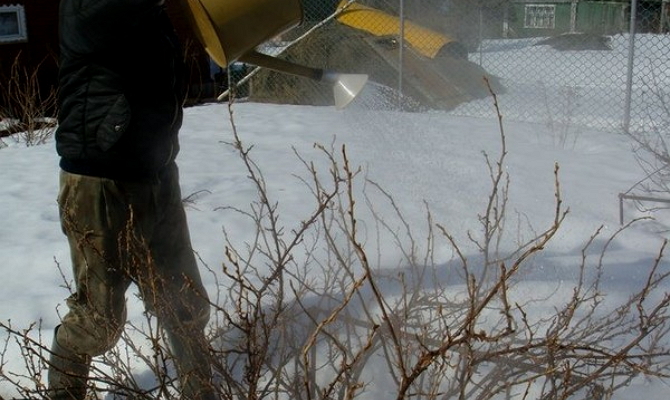
However, there good method during which currants are watered with boiling water. This is a proven way to get rid of the bud mite, which brings maximum harm to the plant. On the surface of the stems, it creates terry, which negatively affects the life of the bushes. Even in early autumn, they hibernate in the kidneys. Here, the females lay offspring, which, with the advent of spring, nibble on the leaves and the plant becomes more and more oppressed every day. Watering with boiling water will make it possible to avoid the appearance of uninvited guests and ensure a healthy harvest.
When to process
When to water currants with boiling water? The effectiveness of this procedure depends on the right time. Watering currants with the onset of autumn is ineffective. During this period, the kidneys are protected by a thick crust and the pests feel completely safe there. Therefore, it will not be advisable to act with boiling water in this case. However, if you missed the moment, then heat treatment held in mid-November. At the same time, you need to make sure that even the smallest leaves do not remain on the branches.

Irrigation technology
You need to irrigate the bushes with boiling water as quickly as possible, while the water is still very hot. As a rule, currants are planted along the fences, and possibly at the end of the site. By the time you bring a hot watering can to her, she will cool down a bit on the way, which will reduce the effect of the procedure. The temperature can drop by 20-30°C. If the temperature level drops too low, then no watering effect can be achieved.
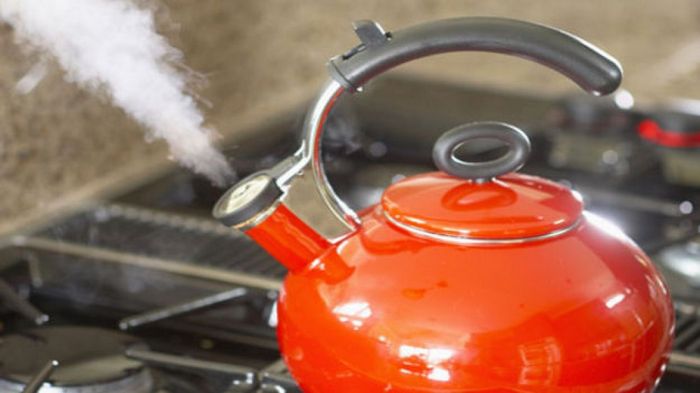
The bushes are watered with boiling water. Even 80-degree temperature is no longer enough to process currants
To water the bushes, you must first protect their root system. This is necessary when the roots are located very close to the surface layer of the earth. As protection, you can use an additional layer of earth, plywood, tin sheets or other improvised materials.
It is most convenient to pour boiling water over the bushes with the help of a watering can made of metal, at the end of which a sprayer is installed. An analogue made of plastic will change shape under the influence of hot water, and with the help of a bucket it is difficult to control the slow flow of water and its uniform hit on all branches of the bush.
To increase the effect, copper sulfate, salt or a small amount of manganese can be added to the hot liquid.
To treat the bushes with boiling water, it is necessary to bring the water to a boil. At least 5-6 liters are spent on each bush. The heated liquid is poured into a watering can. It must immediately be brought to the place where the currant grows and processed, ideally boil water right there, at a distance of one step.
Water with boiling water evenly so as not to miss a single branch. The water supply must be carried out in such a way as not to linger in one place for more than five seconds. The watering can is held above the branches at a distance of 10 cm.
You can only process once. If after watering it was noticed that some branches remained untreated, then it is impossible to repeat the procedure.
Alternative to boiling water - hot steam
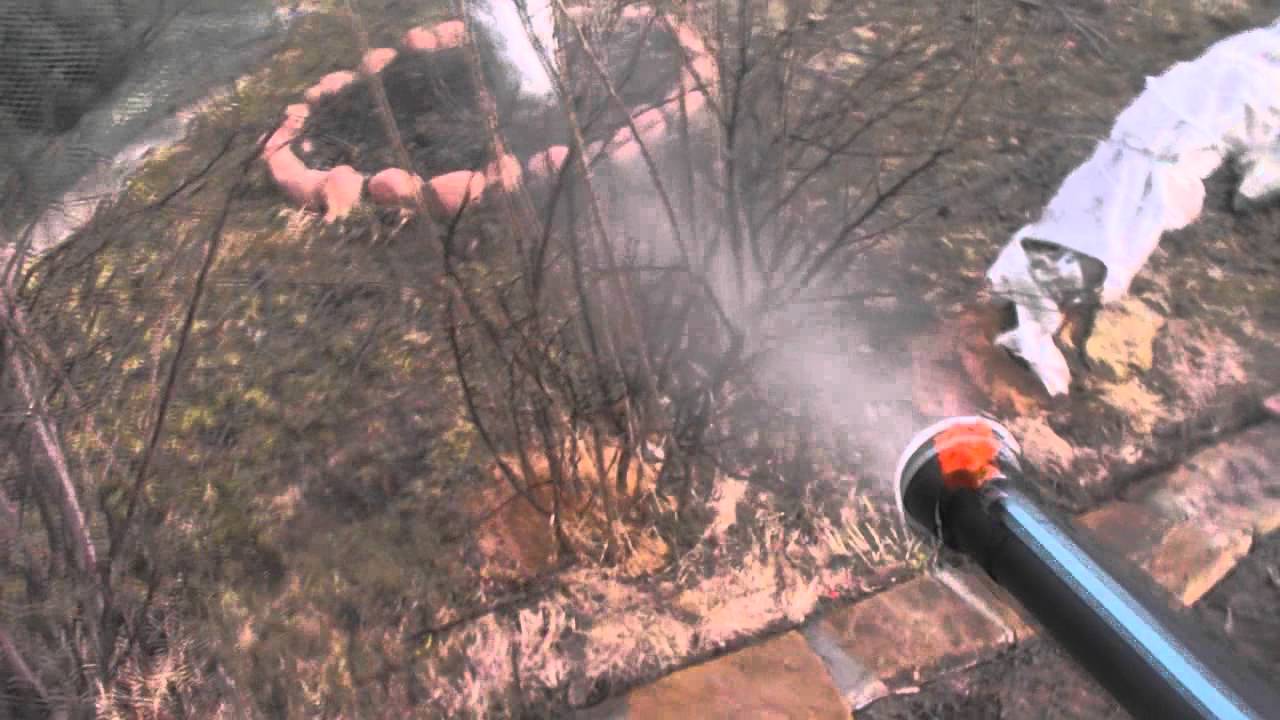
For some, a modified method will be more convenient, in which the bush is covered with a plastic bag, and a bucket of hot water is placed under it. All branches of the plant are wrapped in hot steam. It stays under cover long enough to cause the pests to leave the buds.
What are the benefits of the procedure
- to develop in plants high resistance to the appearance of various diseases;
- increase immunity;
- easily endure harsh weather conditions;
- increase productivity;
- improve fruit flavor.
Irrigation of currants in the spring gives the leaves the opportunity to get a bright green color and look fresh. From this procedure, you can get more shoots during the growing season. The treated plant withstands winter frosts better. The improved growth and health of the plant is due not only to the elimination of the mite, but also to the destruction of aphid spores and other pests.
VIDEO: Processing blackcurrant bushes in early spring with boiling water
